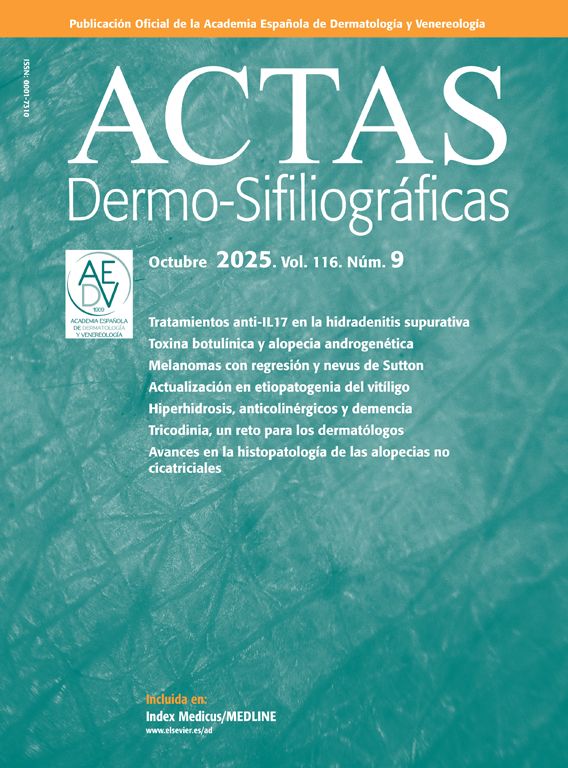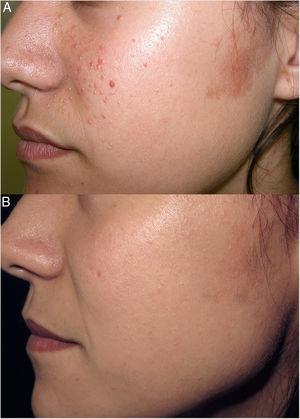We read with great interest the article entitled ‘Onychopapilloma: a potential mimicker’ by Arias Rodriguez et al.1 They describe 2 patients, each with a nail tumor diagnosed as onychopapilloma. In one case, the clinical impression of onychocytic vs connective tissue tumor was raised and in the other, squamous cell carcinoma vs viral wart.1
Onychopapilloma is a benign nail of the distal nail matrix and proximal nail bed. Five cases of atypical/malignant onychopapilloma have been recently published.2,3 The different forms of clinical presentation, dermoscopy and histology have been described in the literature.4 Clinically, onychopapilloma presents with longitudinal chromonychia, a characteristic subungual focal hyperkeratosis, and often thinning of the nail plate and splitting of the distal nail plate.
There are times when the clinical diagnosis of nail lesions is not easy to establish due to the lack of clinical specificity. In the first case reported by Arias Rodriguez et al., the clinical images, the manuscript description, and the dermoscopy features seem to correspond to a giant onychomatricoma.5 Clinical figure shows a nodule on the edge of the proximal nail fold, pachyonychia, and a well-demarcated transverse and longitudinal overcurvature of the nail. On dermoscopy, the distal free edge was thickened with shallow pits containing white and dark dots, in a typical nail wall-like pattern without perforations. In case #2, the dermoscopic image reveals thickening of the nail plate with multiple hemorrhagic dots in both the nail plate free edge and nail plate itself, which is indicative of onychomatricoma, among other differential diagnoses.
Histology pictures provided by Arias Rodriguez et al. in case #1 show a large cystic cavity occupied by a serohemorrhagic material, limited by epithelium with remains of parakeratosis surrounding the cavity (Figure C), and hyper- and parakeratosis foci with arranged in papillary views in the matrix epithelium (Figures A and B). These features are characteristic of onychomatricoma, and correlate with the typical papillary views of the matrix epithelium, which end up determining a thickened nail plate, and cystic cavities with serohemorrhagic content surrounded by epithelium, which are in continuity with the above-mentioned views.6 Regarding immunohistochemistry, it would be necessary to demonstrate the presence of spindle cell stromal cell proliferations in the lesion, which are not shown in the picture, to be able to correctly assess the immunostaining with CD34; if these cells are not present in the original sample, the negativity of this marker as referred to in the article has no diagnostic value.
In the images provided by Arias Rodriguez et al. of case #2, only a small portion of the matrix can be evaluated; typical features of onychopapilloma, such as the papillary views of the epithelium with hyper- and parakeratosis and eosinophilia and multinucleation of the keratinocytes were not identified. Therefore, diagnosis is consistent with the clinical diagnosis of onychomatricoma.
Onychomatricoma is a fibroepithelial tumor clinically characterized by thickening of the nail plate, transversal and/or longitudinal overcurvature, xanthonychia, numerous splinter hemorrhages and frontal visualization of honeycomb-like cavities.8 Other presentations include nail dystrophy, erythronychia, melanonychia, plate fracture, paronychia, and dorsal pterygium. Onychomatricoma can easily mimic many other nail tumors and diseases. Dermoscopy features include longitudinal parallel white lines, parallel lesion edges, splinter hemorrhages, dark dots, nail pitting and thickening of the free edge.7 Histologically, it is a fibroepithelial tumor of the nail matrix composed of a proximal pedunculated base and a distal area that sends multiple fibroepithelial projections toward the nail plate covered by epithelium, which does not have a granular layer. Tumor cells in the stroma are positive for CD34 and negative for CD99 and S100, and other mesenchymal markers.6
In conclusion, the clinical, dermoscopic and histologic features of the 2 published case reports1 are, in our view, consistent with onychomatricoma rather than onychopapilloma. This situation highlights the difficulty of diagnosing nail tumors and the need for establishing a careful clinical-pathologic correlation.
FundingThere is no funding to write this manuscript.





